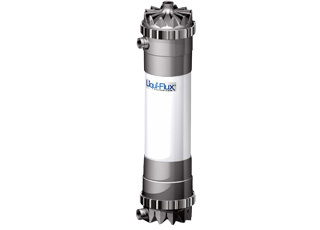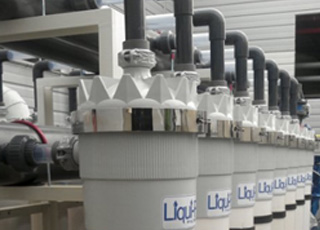PRODUCT » MEM- SEP PRODUCTS
Evergreen’s speciality product division has the following innovative technologies and representations:
» |
SnowPure LLC, USA since 2003 | Brand Name: “ELECTROPURE” | Electrodeionization (for Ultrapure water application) |
» |
Membrana-Charlotte, USA since 2007 | Brand Name: “LIQUI-CEL” | Liquid Degasification (for removal of dissolved gases in water) |
» |
Membrana GmbH,Germany since 2012 | Brand Name : “LIQUI-FLUX” | Ultrafiltration (Ultrafiltration membranes for water & waste water treatment) |
1. RESPONSIBILITIES & SERVICES
Evergreen’s speciality product division is responsible for the following activities
- Provide technical support to OEMs, end users and consultants for design, operation and maintenance, trouble shooting and installation and commissioning services
- Customized training covers the basic principles and design of Electropure EDI (electro deionization), Liqui-Cel membrane contactors (Liquid degasification) and Liqui-Flux ultrafiltration membrane
- Preparation of drawing such as P&ID with required control philosophy
- After sales service for improvement, upgradation and modification of the system
- Evergreen Technologies Pvt. Ltd. has full-fledged Service Centre at Vashi (Navi Mumbai) for servicing, diagnosis, assessing problem failure and taking remedial action and replacement of spare parts. Evergreen maintains complete spare parts required to retrofit EDI modules. This is a great advantage to our customers as only those parts which are damaged are replaced.
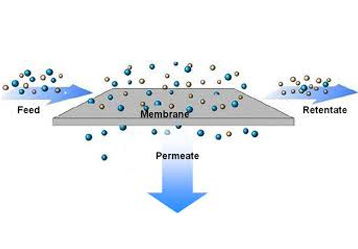
2. ELECTROPURE EDI
The Electropure EDI is manufactured by SnowPure LLC, USA, makers of high purity water modules (www.snowpure.com)
The EDI module replaces the conventional mixed bed DI unit which produces high purity water upto 18.2 Meg-Ohms - cm resistivity unlike mixed bed unit which requires regeneration. Electropure EDI does not require regeneration.
The Electropure EDI design combines two well-established water purification technologies – electrodialysis & ion-exchange resin deionization . Electopure’s EDI removes ions by forcing them out of the feed streams via an electric potential . This process uses a combination of ion-selective membranes & ion exchange resins sandwiched between two electrodes ( anode (+) and cathode(-) under a DC voltage potential to remove ions from RO pretreated water. Result is very low conductivity ultrapure water which can be produced continuously up to 18.2 Meg-Ohms - cm resistivity.
| ADVANTAGES OF EDI OVER CONVENTIONAL DEIONIZATION SYSTEM | |
» |
Consistent quality from 1 - 18.2 Meg-Ohms -cm resistivity or 1-0.057 micro siemens / cm conductivity |
» |
Continuous process, no shutdown required |
» |
No regeneration required |
» |
Compact size |
» |
Low energy |
» |
Economic use of capital-saves operating expenses |
| TYPICAL APPLICATIONS | |
» |
Pharmaceutical industries |
» |
Purified water |
» |
Water for Injection (WFI) |
» |
Automobile Industries |
» |
Power stations |
» |
Boiler feed water |
» |
Process industries |
» |
Laboratories for process water |
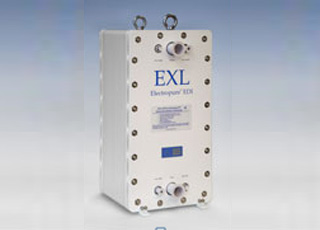
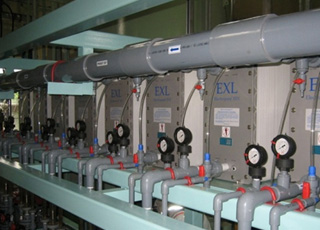
3. LIQUI-CEL MEMBRANE CONTACTOR
Liqui-Cel membrane contactors are manufactured by Membrana, Charlotte, USA, makers of liquid degasification contactors ( www.membrana.com / www.liqui-cel.com ). Liqui-Cel membrane contactors are widely used for removal of dissolved gases such as oxygen, carbon dioxide, nitrogen and ammonia in aqueous solution. Membrane contactors are typically shell-and-tube device containing microporous hydrophobic, hollow fibres. The material of construction of hollow-fibre is polypropylene having internal diameter 200-220 microns, outer diameter 300 microns and having an average pore size of 0.03 microns. Water is passed on outside of the membrane ( shell side) and a gas is passed inside of the membrane (lumen side). Since the membrane is manufactured using a hydrophobic material and the pores are small, water does not easily pass through the pores. The membrane essentially acts as a support between the gas and liquid phases and allow them to interface at the pores. Gases, however, freely pass through the pores on a molecular level. sweep gas as air or nitrogen and either/or vacuum is applied inside the fiber which results in reducing the partial pressure of the gas to be removed. The water leaving the membrane contactor will be degassed.
| ADVANTAGES OF LIQUI-CEL MEMBRANE CONTACTOR | |
» |
Proven technology |
» |
Accurate performance |
» |
Smaller foot prints |
» |
Low operating cost (low power consumption) |
» |
Eliminates feed transfer pump and degassed water storage tank |
» |
Capacity can be increased based on modular design |
» |
Flexibility in operation |
» |
Achieve oxygen level of 1 ppb and carbon dioxide of 1 ppm |
| TYPICAL APPLICATIONS | |
» |
Boiler Feed Water : Oxygen removal |
» |
Pharmaceutical : Carbon dioxide removal |
» |
Removal of non-condensable gases in pure steam generator |
» |
Power : Oxygen and carbon dioxide removal |
» |
Micro electronics : Oxygen and carbon dioxide removal |
» |
Beverage : Carbon dioxide injection & oxygen removal |
» |
Humidification of gases in pharma and prosess industries |
» |
Printing : Degassing of inks and coatings |
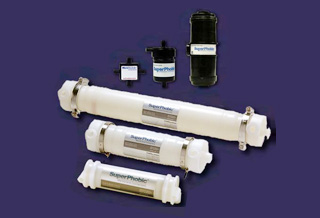
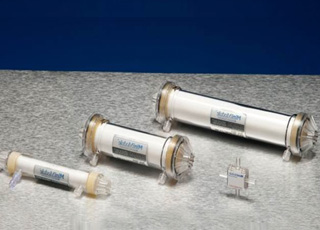

4. LIQUI-FLUX ULTRAFILTRATION MEMBRANES
Liqui-Cel membrane contactors are manufactured by Membrana, Charlotte, USA, makers of liquid degasification contactors ( www.membrana.com / www.liqui-cel.com ). Liqui-Cel membrane contactors are widely used for removal of dissolved gases such as oxygen, carbon dioxide, nitrogen and ammonia in aqueous solution. Membrane contactors are typically shell-and-tube device containing microporous hydrophobic, hollow fibres. The material of construction of hollow-fibre is polypropylene having internal diameter 200-220 microns, outer diameter 300 microns and having an average pore size of 0.03 microns. Water is passed on outside of the membrane ( shell side) and a gas is passed inside of the membrane (lumen side). Since the membrane is manufactured using a hydrophobic material and the pores are small, water does not easily pass through the pores. The membrane essentially acts as a support between the gas and liquid phases and allow them to interface at the pores. Gases, however, freely pass through the pores on a molecular level. sweep gas as air or nitrogen and either/or vacuum is applied inside the fiber which results in reducing the partial pressure of the gas to be removed. The water leaving the membrane contactor will be degassed.
| ADVANTAGES OF LIQUI-CEL MEMBRANE CONTACTOR | |
» |
Proven technology |
» |
Accurate performance |
» |
Smaller foot prints |
» |
Low operating cost (low power consumption) |
» |
Eliminates feed transfer pump and degassed water storage tank |
» |
Capacity can be increased based on modular design |
» |
Flexibility in operation |
» |
Achieve oxygen level of 1 ppb and carbon dioxide of 1 ppm |
| TYPICAL APPLICATIONS | |
» |
Boiler Feed Water : Oxygen removal |
» |
Pharmaceutical : Carbon dioxide removal |
» |
Removal of non-condensable gases in pure steam generator |
» |
Power : Oxygen and carbon dioxide removal |
» |
Micro electronics : Oxygen and carbon dioxide removal |
» |
Beverage : Carbon dioxide injection & oxygen removal |
» |
Humidification of gases in pharma and prosess industries |
» |
Printing : Degassing of inks and coatings |



4. LIQUI-FLUX ULTRAFILTRATION MEMBRANES
Liqui-Flux ultrafiltration membranes are manufactured by Membrana, Wuppertal, Germany market leader in membrane technology (www.membrana.com / www.liqui-flux.com).
Liqui-Flux ultrafiltration membranes are microporous, hollow fiber, polyethersulfone membrane which are used to filter or separate microorganisms down to macromolecules from water. The ultrafiltration membranes are typically engineered to provide large membrane separation area in a housing well designed to allow uniform flow of the feed liquid on one side of the membrane and the permeate/filtrate on the other side. The fluid flows from the inside of the hollow fiber membrane to the outside of the membrane.
| ADVANTAGES OF LIQUI-FLUX ULTRAFILTRATION MEMBRANES | |
» |
Pronounced asymmetric structure |
» |
Narrow pore size distribution |
» |
Optimized relation between permeability at low cut-off results ( true UF membranes) |
» |
Lower energy consumption when compared to out-in with PVDF membranes (even MF membranes) |
» |
Resistant from pH 1 to 13. Allows effective cleaning |
» |
Less chlorine required (just neutral salts instead of hypochloric acid for PVDF which generates harmful disinfection by –products ( DBPs), such THMs.) |
» |
Three layer structure generated high mechanical strength and maintain membrane integrity |
» |
Hydrophilic surface reduces fouling potential resulting in fewer cleaning cycles |
| TYPICAL APPLICATIONS | |
» |
Reverse Osmosis pretreatment |
» |
Waste water reuse |
» |
Drinking water |
» |
Process water |
» |
Swimming pool |
» |
Beverage filtration |
